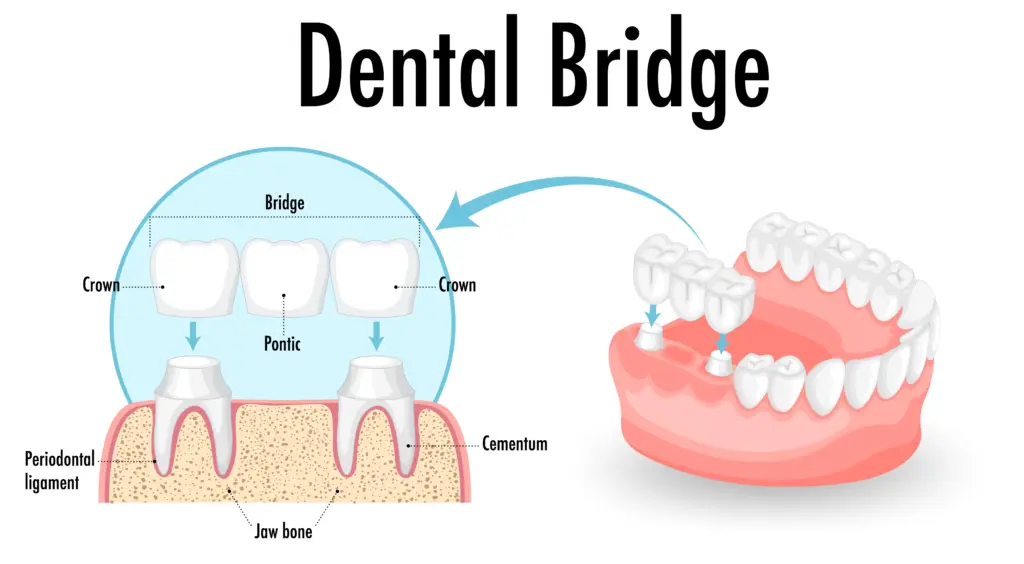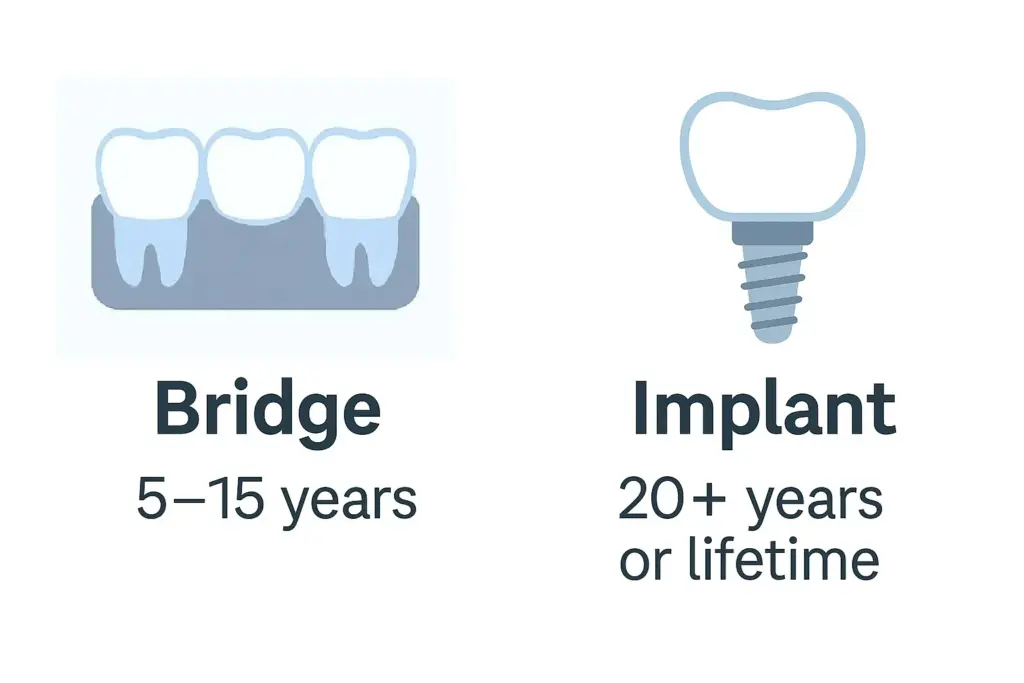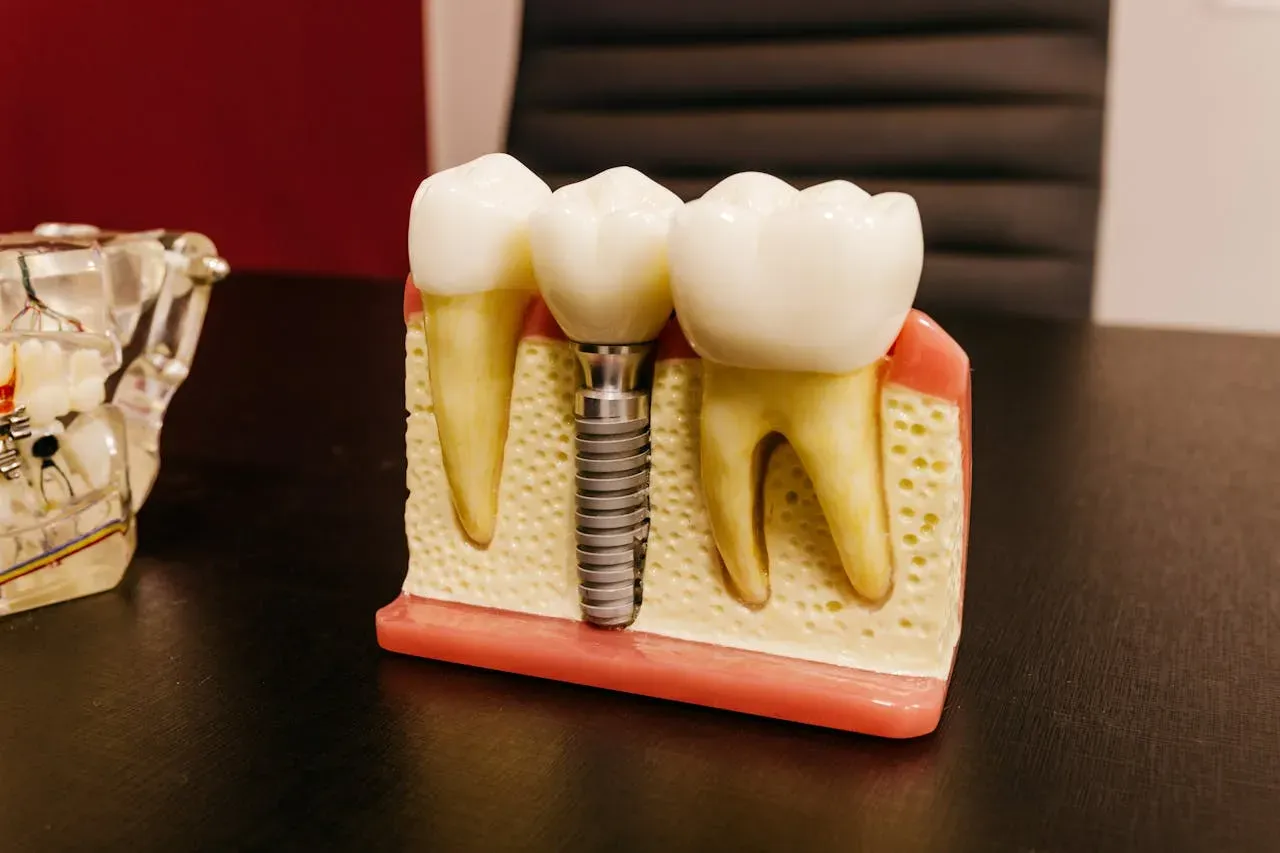Losing a tooth can affect much more than just appearance; it can make eating more difficult, impact speech, and reduce confidence. Fortunately, modern dentistry provides reliable ways to replace missing teeth, with two of the most popular options being dental bridges and dental implants.
When deciding on the right treatment, it helps to understand how each option works, its benefits and drawbacks, and what might make one more suitable than the other.
Understanding the difference between a dental bridge and a dental implant
Both bridges and implants are designed to replace missing teeth, but the way they do this is quite different.
What is a dental bridge?

A dental bridge has been used successfully for many decades as a common solution to tooth loss. It works by creating a false tooth (or teeth) called a pontic, which is supported on either side by crowns fitted to the natural teeth.
Because those supporting teeth need to be filed down to hold the crowns, the procedure is irreversible. However, once fitted, a bridge blends naturally with the rest of the smile and restores function quickly.
- Structure: One or more artificial teeth attached to crowns.
- Integration: Rests on existing teeth, not the jawbone.
- Advantages: Shorter treatment time, no surgery required, usually less expensive upfront.
- Limitations: Healthy teeth must be reshaped, higher risk of decay in supporting teeth, and does not prevent bone loss in the jaw.
What is a dental implant?
Dental implants are a more modern solution and are widely recognised as a reliable and long‑term option. Unlike a bridge, which relies on other teeth, an implant is secured directly into the jawbone using a titanium post. Over time, this post fuses with the bone, creating a strong foundation for a crown.
This integration mimics the function of a natural tooth root, helping to preserve bone density and facial structure.
- Structure: Titanium screw surgically placed into the jawbone with a crown fitted on top.
- Integration: Fully anchored in the bone through osseointegration.
- Advantages: Very long‑lasting, preserves jawbone health, does not damage neighbouring teeth.
- Limitations: Requires surgery and healing time, higher upfront cost, not suitable for everyone.
Advantages of dental bridges
Bridges remain popular because they are less invasive and relatively quick to complete. In many cases, treatment can be completed in two or three visits over just a few weeks.
Key benefits include:
- Faster results than implants.
- No surgical procedure involved.
- Lower upfront costs.
- A good choice if jawbone density is too weak for implants.
- Effective for replacing one or more missing teeth in a row.
For patients who prefer to avoid surgery or who are looking for a practical solution on a shorter timeline, bridges can be the ideal choice.
Advantages of dental implants
Implants are more complex to place but offer significant long‑term benefits. They behave much like natural teeth and help maintain both appearance and oral health.
Notable advantages include:
- A typical implant can last decades or even a lifetime.
- They do not require reshaping or altering other teeth.
- They preserve bone health, reducing the risk of gum shrinkage and changes to facial appearance.
- They provide stable chewing and biting function without risk of slipping or movement.
At Birchgrove Dental, many patients choose implants for their durability and natural feel, especially when seeking a permanent, reliable solution.
How long does a dental bridge last compared to an implant?

Longevity is often the deciding factor when weighing up the options.
- Dental bridge lifespan: Most bridges last between 5 and 15 years. Lifespan depends on oral hygiene, diet, and the health of supporting teeth. However, because those supporting teeth carry additional stress, they can sometimes weaken, leading to earlier failure.
- Dental implant lifespan: Implants are designed to be long‑term. With proper care, they can last 20 years or more, and in many cases, a lifetime. Learn more about how long dental implants last in detail.
Evidence from the Association of Dental Implantology shows that dental implants achieve survival rates of 95-97% at five years, with crowns supported by implants averaging 95% survival at ten years. By comparison, guidance from the Leeds Teaching Hospitals NHS Trust notes that most bridges last five to fifteen years, although they can sometimes fail sooner if the supporting teeth weaken.
Costs and considerations when choosing between a bridge and an implant
Cost is often one of the first questions patients ask.
- Dental bridges generally cost less initially.
- Dental implants are more expensive at the outset, but their durability means they may be more cost‑effective over time.
Eligibility is also a key factor. Patients with insufficient jawbone density, smokers, or those with certain medical conditions may not be suitable candidates for implant surgery. In such cases, a bridge may be the better alternative.
Alternatives to bridges and implants
While bridges and implants dominate most treatment plans, other alternatives exist. Removable dentures are a traditional solution, particularly when multiple teeth are missing. Although they are not fixed in place, they remain a practical and sometimes more affordable option. For comparison, see this guide to dental implants vs dentures.
For patients interested in improving overall appearance, other cosmetic options such as bonding, veneers, or whitening can also enhance a smile. Birchgrove offers a broad range of cosmetic dentistry treatments tailored to patients’ needs.
Factors to consider before making a decision
The choice between a bridge and an implant is never the same for everyone. Dentists typically assess:
- The health and condition of the surrounding teeth.
- The strength and density of the jawbone.
- The patient’s age, lifestyle, and medical history.
- Budget and long‑term expectations.
- How many teeth need replacing.
A professional consultation is the best way to weigh these factors and decide which treatment offers the most benefits for the individual.
Final thoughts
Both bridges and implants provide effective ways to restore missing teeth. A bridge may be suitable for those looking for a quicker, less invasive treatment, while implants remain the most durable and natural‑feeling option for long‑term oral health. The best step forward is to seek personalised advice from a trusted dental professional. Birchgrove Dental can help assess your individual needs and guide you towards the treatment that will restore both your smile and your confidence.




